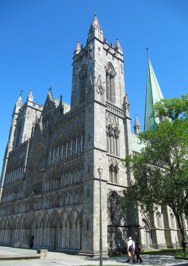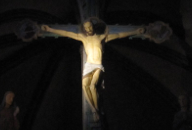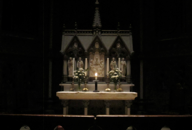nidaros cathedral
Trondheim, trøndelag, norway
scandinavia
July 5, 2010


nidaros cathedral
Trondheim, trøndelag, norway
scandinavia
July 5, 2010


The most prominent building in the city of Trondheim is Nidarosdomen or Nidaros Cathedral. Henry and I found this outstanding building without needing a map, as the spire of the cathedral indicated Trondheim’s geographical center, from which all distances are measured. The tower was begun in the 11th century, with the middle section added between 1230-40, with the upper floor of the tower built between 1890-1900. The spire of the cathedral was erected in 1901. The cathedral was begun in the year 1070 and grew in stages of construction over a period of 230 years, most of it completed in 1300. The church was built in the Romanesque and Gothic styles, with several outstanding architectural features including a central spire flanked by turrets, and two towers placed far apart, between which is its most outstanding feature, the West Front, begun in 1248. This wide façade, known as a Screen Front, was developed in England in the 13th century. Four horizontal rows of gothic niches on this “screen” are separated by columns, each of which holds a stone sculpture. The bottom row represents the apostles, the middle row depicts the saints, with the four Norwegian saints depicted on this middle row to the left. The upper row of the façade is represented by prophets and kings from the Old Testament. What is interesting about the carvings is the placement of symbols as identification. For example, Jonah, who was swallowed by a whale and thrown ashore three days later, is represented here with a whale carved at his feet. The oldest part of the cathedral is the transept, built on each side of the main tower around 1150-70. The three levels of this part of the church begin in Norman style using chevron ornamentation, the second and third floors are characterized by a more simple style using foliage in what is known as the Cistercian style. The roof of the transept was replaced in 1900, copying the style from medieval churches in the region of Trøndelag. The large nave of the church, built between 1240-1280, is often compared to a ship, which is an old symbol for a church. The architecture is inspired by English churches, principally Westminster Abbey in London and the choir of Lincoln Cathedral. After the great fire of 1531, the nave remained roofless until it was restored between 1898 and 1930. Nidaros Cathedral has a 700 year long history of organs and organists. The first mention of an organ in the cathedral’s records is dated 1319, while the most valuable organ in the cathedral is a baroque organ, installed in 1741. This beautiful organ was built in Germany in 1739 by Joachim Wagner (1690-1749) a renowned organ builder at the time. His organs were used by Johan Sebastian Bach, among others. This organ has 30 registers an 1,809 pipes and is used by organists the world over to give concerts and record their music. The most recently installed organ, added to the cathedral in 1930, is the Steinmeyer organ, built in Bayern, Germany. This instrument, with 127 registers and 9,581 pipes, is one of the largest organs in Europe. While Henry and I were touring the cathedral, we had the chance to hear an organ recital on the Joachim Wagner organ, a truly beautiful instrument. Even with all this breathtaking beauty and power, the single most revered piece of art in the cathedral is “Olav’s Frontal”*, the altar front dating from the Middle Ages, c. 1300. The original is now exhibited in the Cathedral Museum, while a copy has ben placed in the east chapel of the octagon. Nidarosdomen or Nidaros Cathedral was the cathedral of the Norwegian archdiocese between 1152 and 1537. Since the Reformation, it has been the cathedral of the Lutheran bishops of Trondheim and has been an historically important destination for pilgrims coming from all of Northern Europe.
*St. Olav is a Norwegian saint who died in battle. On the frontal piece of the altar, four scenes from the life of the saint are depicted as follows:
NOTE: Details on the Altar: Note St. Olav was King Olaf II of Norway, defeated in the Battle of Stiklestad in 1030. He was martyred as a saint and sowed the seed for the growth of Christianity in Norway. The following depictions are on “Olav’s Frontal”:
•On his way to Stiklestad, Olav gives a bag of money to a farmer. The money is to be used to save the souls of his enemies who would be killed in the battle. His own men who fell did not require prayers, as they would go directly to heaven.
•Olav’s dream before battle: he dreamt that he saw a ladder reaching from earth to heaven. Christ was standing at the top of the ladder, giving his blessings. This was a sign that Olav would die in battle.
•Olav is depicted dying in the Battle of Stiklestad on July 29, 1030. Olav has thrown away his sword and shield, then dies as a saint, offering no resistance.
•Olav’s enshrinement after he is declared a saint in 1031. His three fatal wounds are visible. Olav is wearing a crown and has a pillow under his head. Two bishops are sprinkling holy water and oil on the saint.
PHOTOS: Left Column: 1. Partial view of Nidaros Cathedral. 2. Detail: The West Front. The four Norwegian saints are depicted on the left side of the middle row, each in its own niche, separated by columns. 3. View of Christ crucified on the cross, a Christian symbol displayed on the main altar. 4. Detail view of the West Front. Center, Top: The copper spire, c. 1901 sits atop the Main tower, its lower level dating from 11th century, the middle level dating from the 13th century, and the upper level dating from the 19th century. Center, Middle: The Rose Window, c. 1908-1934 by Gabriel Kielland. The artist created 118 windows, installed where stained glass windows would have existed in the Middle Ages. Center, Bottom: The altar with “Olav’s Frontal”, the most important work of art in the cathedral, described in the footnote above. Right Column: 1. View of Nidaros Cathedral with its West Front in the style of the English screen, c. 13th century. 2. Detail: stone carving above the main portal of the cathedral, Christ crucified. 3. The main altar in the nave o the cathedral. 4. Detail from the West Front, middle row: Stone sculpture of Jonah, with a whale at his feet.

Nidarosdomen










